Many purifier systems use
activated carbon filters as the first filter, carrying out the role of a mechanical pre-filter. There are many different grades of carbon, ranging from
granulated activated carbon (GAC) to premuim ultra compact activated coconut shell carbon. With some systems, if this filter is used to filter out sediments, then iron and even calcium will plug up the microscopic areas of adsorption, shortening its effective life considerably. The carbon filter removes a host of contaminants such as chlorine, pesticides, herbicides and other inorganic materials.
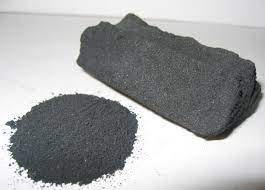 Solid Carbon Block vs. Loose Carbon
Solid carbon media can often be subject to “channeling.” Channeling refers to water passing through least resistant path of the carbon pores, thus reducing contact time with carbon. The result? Your water can pass right through the solid carbon media on these “familiar, friendly pathways” with only a minimum of filtering! Loose Carbon Media, on the other hand, can be periodically repositioned by means of a hot-water backwash, or in some cases by tapping or shaking the filter medium itself. This means that your water will not be able to establish those familiar, friendly pathways that enable it to pass through your system virtually. (Solid carbon media makers would probably disagree.)
Carbon Filtration: What It Does, What It Doesn’t
by Gene Franks, Pure Water Products
The largest single section in the of the “EPA Regulated Water Contaminants” published in
Water Technology magazine, is the section on Organics (including VOCs, or “Volatile Organics”). In this category the EPA lists 32 very nasty chemical contaminants—many with familiar names like benzene, 1,1 dichlorethylene, carbon tetrachloride, dioxin, styrene, toluene, chloroform, and vinyl chloride. To give an idea of the extensiveness of this list, a single one of the 32 items is “Total Trihalomethanes,” a category made up of still uncounted chemicals, assumed to number in the thousands, that are formed when water containing organic matter (i. e., virtually all water) is treated with chlorine. The maximum allowable level for trihalomethanes, which are suspected cancer causers and are present in virtually all chlorinated tap water, is only 1/10 of one part per million. For the Organics category, the primary treatment in
all cases and the only recommended treatment in most cases, is activated carbon.
The EPA’s Pesticides category lists 14 familiar poisons such as Aldicarb, Chlordane, Heptachlor, and Lindane. In all 14 cases, activated carbon is the
only recommended treatment. Of the 12 Herbicides listed (2,4-D, Atrazine, etc.), activated carbon is the
only treatment recommended.
For Organics, Pesticides, and Herbicides, the standard treatment, and in most cases the only treatment recommended, is activated carbon.
When people say water filter, they most frequently mean a carbon filter of some variety, because since the Egyptians discovered that storing water in charcoal made it stay fresher and taste better, carbon has been a standard feature in water treatment. Its centuries of popularity attest to its effectiveness.
What carbon filtration doesn’t do can be seen in the remaining three categories of the EPA contaminant list. Carbon is mentioned as a treatment for only one of the four Microbiological contaminants listed: turbidity. It is not recommended for coliform removal or for cysts, though ironically, some of the very tight solid carbon block filters now on the market remove bacteria (though manufacturers seldom make this claim) and cysts like giardia and cryptosporidium quite handily. Multi-Pure solid carbon blocks, in fact, were the first filtration device certified by NSF (the most prestigious independent agency that tests and certifies product performance) for removal of cryptosporidium. Multi-Pure and some other very tight carbon block filters remove cysts simply because of their restricted pore size. Multi-Pure blocks are absolute 1/2 micron filters, making cryptosporidium organisms about ten times too fat to go through the holes. Thus, although other types of very tight filtration might work as well, the very dense carbon block filters now on the market are very effective against certain forms of microbiological contaminants.
The same is true in the Inorganic category. Activated carbon itself appears in the EPA list as a preferred treatment only for mercury, but carbon block filters can also be engineered to remove lead. Some are NSF-certified for lead removal and for asbestos removal. By and large, however, removal of inorganics is the property of reverse osmosis, distillers, and ion exchange systems.
The same is true in the final category, Radionuclides, where carbon is ineffective and reverse osmosis (RO) and ion exchange are definitely the treatments of choice.
If you are considering a home water filtration system, here are some things to keep in mind:
Chlorine was not considered in the discussion above because EPA does not consider it a water contaminant. Although this is patently absurd, it is also politically expedient and not likely to change soon. (Keep in mind that all EPA maximum contaminant allowables are politically negotiated figures that do not necessarily have any basis in reality. They represent a compromise between the ideal and what can practically be done by water treatment plants.) Chlorine removal is what carbon is best at, and nothing else equals carbon’s ability to remove chlorine.
When distiller sellers or zealous MLMers show you a chart that indicates that reverse osmosis (RO) units do not remove chlorine or certain chemicals, keep in mind that RO units contain one or more carbon filters. In fact, “thin film” RO units, the most common type,
must remove all chlorine from the water as the very first operation else the unit’s membrane will be destroyed. Such statements are simply advertising cheap shots that are technically true but practically false. [The truth is that the RO membrane does not remove chlorine, but that the carbon filter that precedes it does.] Distillers, similarly, have great problems with chlorine and VOC removal. Tap water should always be carbon filtered before distillation, else the VOCs and chlorine will re-enter the distilled water or will be released into the air for you to breathe.
Contaminants that people most frequently want removed that are not readily removed by carbon filtration are fluoride, nitrates, and sodium. Reverse osmosis and distillation remove all three, so either combined with a high quality carbon filter provides complete treatment. All three can also be removed by selective, non-carbon filters designed for the purpose. For example, you can obtain a double filter with one fluoride and one carbon cartridge if fluoride removal is desired.
All carbon filters are not created equal. Some perform much better than others, and some are designed for selected special purposes. Performance depends upon the amount and the type of carbon, the way the filter is designed, and the residence time of the water. Carbon blocks in general work better than GAC (granular activated carbon) filters, though many of the latter can do a fine job. GAC is usually of the consistency of coffee grounds, so it is subject to “channeling” and “fluidizing.” If you don’t believe that water can cut channels, look at the Grand Canyon. Solid carbon blocks keep the carbon in place and do not let it wash away.
Filter carbon is a manufactured product. Though it is sometimes erroneously called charcoal, it is actually a carbon material that has been treated by steam and high temperature in the absence of oxygen.
There are many types of carbon. Most filter carbon is manufactured from coal, but other substances like wood and nut shells are also used. Coconut shell carbon
is becoming popular not only because it is made from a renewable resource but also because it produces very good tasting water and is particularly good at trihalomethane removal. A new specialty carbon called catalytic carbon is now available that will remove hydrogen sulfide gas (which produces the “rotten egg” smell in some well water) and is very good at removing chloramines (the mixture of ammonia and chlorine used as a disinfectant by some water supplies).
Carbon filters remove chemicals by the process of adsorption (as opposed to absorption). Webster’s Collegiate Dictionary defines adsorption as “the adhesion in a thin layer of molecules to the surfaces of solid bodies in which they are in contact.” Carbon attracts certain chemicals at the molecular level much in the way that a magnet attracts and holds metal filings. When the surfaces are full, the filter must be discarded and replaced.
Timely cartridge replacement is very important, because filter carbon has different capacity for different contaminants. Many people rely on chlorine removal tests to determine when filter carbon should be renewed. This works only if chlorine removal is all you expect from the filter. Most carbon filters will begin to “leak” other chemicals long before they begin to allow chlorine to pass. For example, the MatriKX 1+ extruded carbon block used in most PWP RO units and carbon filtration units has an amazing 20,000 gallon chlorine removal capacity (when operated at .75 gallons per minute), but the same filter loses its effectiveness at trihalomethane removal at about 750 gallons. It should, therefore, be replaced annually although it will still have lots of chlorine removal capacity left.
Filter makers rate filters in “microns.” Microns are a size measurement of the pore size, so the smaller the number, the tighter the filter. CTO stands for “Chlorine, Taste, Odor” and means that the maker is saying only that the filter will remove chlorine and improve taste and odor. The filter might do more, but the maker isn't guaranteeing it. CTO-grade cartridges are usually about 10 microns in pore size. Five-micron filters remove more chemicals but will plug up faster if there is heavy particulate matter in the water. One-micron filters are for drinking water only. In general, they are too tight to filter large amounts of water without slowing the flow to unacceptable levels. The new MatriKX CeramiKX block are half-microns blocks.
Filter makers also use the words “absolute” and “nominal” to describe their products’ micron ratings. Absolute means absolute. Nominal means “more or less.” Our CeramiKX .5 micron blocks are absolute .5 micron. That’s as tight as it is practical to make a carbon filter. If it gets tighter, the water won’t go through. The MatriKX +1 is a nominal one micron, meaning it’s very good at getting things in the one to two micron range and larger.
There is in effect a law of diminishing returns in carbon filters. In some ways, the more they do, the shorter their lifespan. Simply stated, a very tight filter plugs up fast because it catches everything. A drinking water filter that promises to last three or five years can do so only because it lets everything smaller than a tennis ball pass.
ABILITY OF ACTIVATED CARBON TO REMOVE VARIOUS SUBSTANCES FROM WATER
Adsorption in activated carbon is an important tool for water purification. It applies especially to dissolved organic substances which are responsible for taste or odor, or may actually be of an irritating or poisonous nature. Also, activated charcoal removes some substances by catalytic reaction (chlorine, for example). Activated carbon also removes certain types of particulate matter by mechanical filtration action, and some substances such as a suspension of an organic vapor by a combination of filtration and adsorption means.
The capacity of activated carbon to remove specific substances and mixtures depends on the nature of the specific chemical compounds, their concentration, conditions of adsorption, such as temperature, pressure, contact time, etc., and how the activated carbon is applied to the problem. :
The accompanying table
classifies the ability to be
removed for specific
chemical compounds and
describable substances and
mixtures according to the
following- arbitrary scale
|
|
0 - Not a logical use for activated carbon.
|
|
1 - Category too broad and non-specific, need more information.
|
|
2 - Possibility. Suggest making laboratory and pilot tests. Success may be a matter of definition.
|
|
3 - Might be an application, either alone or in combination with other treatment methods.
|
|
4 - May be good solution, but special conditions apply, or activated carbon can serve as one step in total treatment. may not be a complete solution in itself.
|
|
5 - Fair application, removed to some degree by activated carbon. Good application, but requires definition of results to be obtained.
|
|
6 - Definite application for activated carbon under some conditions. |
|
7 - Good application, removed in satisfactory quantity by activated carbon.
|
|
8 - Excellent application, removed in high quantity by activated carbon.
|
|
9 - Proven use, probably best solution. |
Since
the above mentioned factors exert
considerable control over capacity,
it must be noted, that the figures
given in the table on the right
are for general guidance only. The
specific case should be tested on
laboratory and pilot scale if it is
a new application.
Coconut Shell Carbon
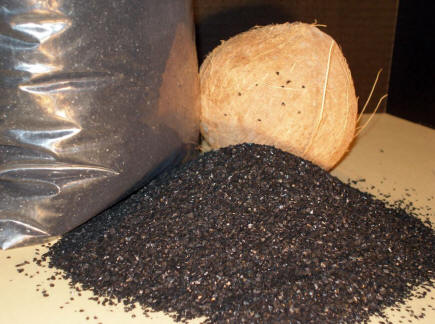
Coal Carbon
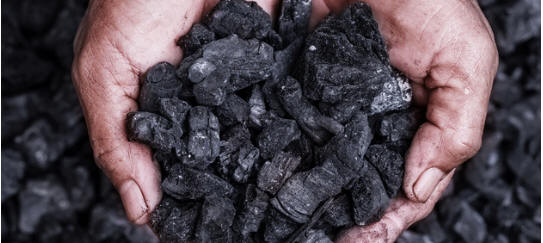
To summarize, carbon is an extremely
versatile and highly effective water
treatment medium. It has immense
surface area. A single pound of
granular activated carbon has a
filtering surface area equivalent to
125 acres! It is the best known
treatment for organic chemicals,
VOCs, pesticides, herbicides,
and chlorine and its by-products. It
is also an unchallenged
taste-and-odor improver. When
arranged in solid carbon or extruded
carbon block format, it also
provides very high quality
particulate filtration, in some
cases down into the sub-micron
level.
|
|
Accidental spills of toxic materials
|
7 |
|
Acetaldehyde |
7 |
|
Acetic add |
7 |
|
Acetone |
8 |
|
Activated sludge effluent |
6
|
|
Air purification scrub water
|
6 |
|
Alcohol |
8 |
|
Alkali |
2 |
|
Amines |
6 |
|
Ammonia |
2 |
|
Amyl acetate |
9 |
|
Amyl alcohol |
9 |
|
Animal excrement |
6 |
|
Antifreeze |
7 |
|
Aquarium water |
7 |
|
Benzenes |
9 |
|
Bilge water |
6 |
|
Biochemical warfare agents |
6 |
|
Bleaching solutions 3 |
9 |
|
Boiler blowdown water |
3 |
|
Boiler compounds |
4 |
|
Boiler condensate |
6 |
|
Bottle washing |
6 |
|
Brackish water |
3 |
|
Butyl acetate |
9 |
|
Butyl alcohol |
9 |
|
By-products, organic |
6 |
|
Calcium hypochlorite |
9 |
|
Can, drum washing |
6 |
|
Carbon dioxide |
0 |
|
Cheese manufacturing wash water
|
6 |
|
Chemical tank wash water |
6 |
|
Chloral |
9 |
|
Chloraimne |
7 |
|
Chlorobenzene |
9 |
|
Chlorine |
9 |
|
Chlorophenol |
9 |
|
Chlorophyll |
8 |
|
Cistern water |
7 |
|
Citric acid |
8 |
|
Coal mine drainage water |
0
|
|
Condensation (from ref. coils) |
6 |
|
Cresol |
9 |
|
Dairy or milk processing wash water |
6 |
|
Decayed leaves |
8 |
|
Decayed organic matter |
8 |
|
Decaying substances |
8 |
|
Defoliants |
9 |
|
Deionized water |
6 |
|
Detergents |
6 |
|
Dissolved oil |
9 |
|
Dyes |
9 |
|
Electroplating rinse water |
4 |
|
Emulsions |
4 |
|
Ethyl acetate |
9 |
|
Ethyl acrylate |
9 |
|
Ethyl alcohol |
9 |
|
Ethyl a mine |
8 |
|
Ethyl chloride |
8 |
|
Ethyl ether |
8 |
|
Fermentation slop |
3 |
|
Fertilizers |
3
|
|
Fiber and fabric washing |
3 |
|
Filter backwash |
3 |
|
Fluorides |
4
|
|
Food processing wash water |
4 |
|
Food processing waste |
4 |
|
Formaldehyde |
4 |
|
Fruit processing waste |
3 |
|
Gasoline |
9 |
|
Glycol
|
9 |
|
Hardness |
0 |
|
Herbicides |
9 |
|
Hydrogen bromide |
4 |
|
Hydrogen chloride |
2 |
|
Hydrogen fluoride |
2 |
|
Hydrogen iodide |
4 |
|
Hydrogen selenide |
5 |
|
Hydrogen sulfide |
5 |
|
Hypochlorous add |
9 |
|
Imhoff effluent |
3 |
|
Industrial wastes |
3 |
|
Inorganic acids |
1 |
|
Inorganic chemicals |
1 |
|
Insecticides |
9 |
|
Iodine |
9 |
|
Isopropyl acetate |
9 |
|
Isopropyl alcohol |
9 |
|
Ketones |
9 |
|
Laboratory drains |
3 |
|
Lactic acid |
8 |
|
Lake water |
8 |
|
Laundry effluent |
4 |
|
Leaf extract |
9 |
|
Lime |
0 |
|
Liquid contaminants |
2 |
|
Lysol |
9 |
|
Mercaptans |
8 |
|
Metal salts |
1 |
|
Methyl acetate |
8 |
|
Methyl alcohol |
8 |
|
Methyl bromide |
9 |
|
Methyl chloride |
8 |
|
Methyl ethyl ketone |
9 |
|
Naptha (coal tar) |
9 |
|
Nitric acid |
5 |
|
Nitro benzenes |
9 |
|
Nitrotoluene |
9 |
|
Odor of unknown origin
|
6 |
|
Oil slick |
4 |
|
Organic acids |
8 |
|
Organic esters |
9 |
|
Organic odor |
7 |
|
Organic poisons |
8 |
|
Organic salts |
7 |
|
Organic taste |
7 |
|
Oxalic acid |
9 |
|
Oxidizing agents |
3 |
|
Ozone |
8 |
|
Packing house effluent
|
4 |
|
Paper mill effluent |
4 |
|
Particulate matter |
4 |
|
Phenol |
9 |
|
Phosphates |
0
|
|
Photographic wash water
|
4 |
|
Pickle liquor |
1 |
|
Plastic monomers |
7 |
|
Plumbing drain |
6 |
|
Poisons |
5 |
|
Polluting substances |
3
|
|
Potassium permanganate
|
8 |
|
Precipitated iron |
4 |
|
Precipitated sulfur |
3 |
|
Process drain |
4 |
|
Propionaldehyde |
5 |
|
Propionic acid |
8 |
|
Propyl acetate |
8 |
|
Propyl alcohol |
8 |
|
PropyI chloride |
8 |
|
Putrefying substances |
4 |
|
Radioactive solutions
|
1 |
|
Rain water |
9 |
|
Recycled water |
6
|
|
Residual brine from electrolysis |
3 |
|
River water |
9
|
|
Rubber & plastic hose taste |
9 |
|
Salt water |
2
|
|
Sea water |
2
|
|
Sediment |
2 |
|
Sewage plant effluent |
5
|
|
Soap |
5 |
|
Sodium hypochlorite |
9 |
|
Soluble iron |
4 |
|
Soluble sulfur |
4
|
|
Solvents
|
8 |
|
Sour milk |
5 |
|
Spoiled foods |
5 |
|
Spring water |
9 |
|
Stagnant water |
5 |
|
Starch |
5 |
|
Stick water |
5 |
|
Sugar |
5 |
|
Sulfonated oil |
8 |
|
Sulfuric acid |
3 |
|
Suspended matter |
4 |
|
Suspended oil
|
4 |
|
Sweet water |
8 |
|
Swimming pool water |
8 |
|
Tanning waste |
5 |
|
Tar emulsion |
8 |
|
Tartaric acid |
8
|
|
Taste of unknown origin
|
6 |
|
Toluene |
9 |
|
Toluidine |
9 |
|
Trichlorethylene |
9 |
|
Trickle filter effluent |
6 |
|
Turpentine |
9 |
|
Urine |
4 |
|
Vegetable processing waste
|
4 |
|
Vinegar |
7 |
|
Waste products |
4 |
|
Well water |
9
|
|
Wine industry wash water
|
5 |
|
Wool scouring water |
5 |
|
Xanthophyll |
8 |
|
Xylene |
9 |
|
-
Ozone is a GREAT way to purify your water. Ozone (O3) is the triatomic form of oxygen (O2). It is oxygen in it's most active state and is an extremely potent oxidant that has been shown to posses broad spectrum antimicrobial activity. Ozone is not just another disinfectant. Ozone is a true sterilant. It has the ability to completely destroy not only bacteria, but also viruses, spores, fungus, mold, mildew, cysts, and many other contaminants while at the same time breaking down dissolved organic materials by oxidation. When ozone (O3) breaks down it naturally reverts back to oxygen (O2).
Both the FDA and EPA certify that ozone destroys 99.9992% of all pathogenic germs, while oxidizing (destroying) 99.9992% of all pollutants in the water at the same time.
- Besides just cleaning your water, ozone also can have
very therapeutic effects.
The largest commercial use of ozone is in the purification of water.
In Western Europe, over 40 full-scale municipal ozone facilities are installed each year. France alone has over 700 water treatment plants equipped with ozone. Switzerland has over 80 plants online for disinfecting contaminated water and oxidizing organics in heavily contaminated surface waters. Germany has over 70 installations using ozone. As of 1990, there were more than 40 full-scale ozone installations in the United States.
Doesn't it make sense that since your body is two-thirds water, the same water purification principles would directly apply to us? Ozone is simply infused through your body liquids to sterilize and purify them, and your organs filter out the leftover particulates. With that in mind, many alternative homeopaths recommend drinking Ozonated water to help prevent and fight disease.
more about Ozone
-
see our
Ozone Machines
Steam Distillation
QUALITY distillation is capable of removing all FIVE major categories of water pollution.
Steam distilled water
is produced by a completely natural process: simple
heating and cooling, like earth's natural rain process,
resulting in a product with completely pure qualities. This
is because natural processes are at work in the distillation
system - heat, steam and gravity. Steam is always produced
by the boiling process of distillation while gravity is
always on the job, separating dissolved solids from the
steam.
In our opinion, in general,
home distillers are a great thing to have in your home if
someone is ill. It is very pure. And affordable.
However, there is usually not enough capacity for quality
distillers to provide enough daily water supply to a
family. High quality
filtration
is
usually the more economical, easy, long term solution.
One other reason we use
distilled water is when we are "creating" our own water.
Freshly distilled water is "void" of any "influences" yet.
No poisons, No minerals, No energy, No structure, No
magnetism. This makes it perfect for a "water structurer"
like our
Vitalizer Plus,
which literally brings the distilled water to life. Which
brings you life.
|
"Distilled water is the
greatest solvent on earth. (It is) the only water
that can be taken into the body without damage to the
tissues. What we as
scientists and the public have never realized is that minerals collected in the body from water are all
inorganic minerals, which cannot be assimilated
(digested) by the body. The only minerals that the
body can utilize are the organic minerals (from fruits
and vegetables). All other types of minerals are foreign
substances to the body and must be disposed of or
eliminated.
Today, many
progressive doctors prescribe distilled water to their
patients. All kidney machines operate on distilled
water."
- Allen E.
Banik, M.D. Author, "The Choice is Clear"
"Distilled water should
be used if the usual water supply (tap or bottled)
contains more than 20 mg. of sodium per liter."
American Heart Association(1986)
"When
distilled water enters the body, it leaves no residue of
any kind. It is free of salts and sodium. It is the
most perfect water for the healthy functioning of the
kidneys (83% water). It is the perfect liquid for the
blood (83% water), the ideal liquid for the efficient
functioning of the lungs (86% water), stomach, liver (85%
water) and other vital organs. Why? Because it is free
of all inorganic minerals. It is so pure that all liquid
drug prescriptions are formulated with distilled water.
Dr. Paul Bragg, N.D. Ph.T., from his book: "The
Shocking Truth About Water
"Water Hardness" is
the underlying cause of many, if not all, of the
diseases resulting from poisons in the intestinal tract.
These (hard minerals) pass from the intestinal walls and
get into the lymphatic system, which delivers all of
it's products to the blood, which in turn, distributes
to all parts of the body. This is the cause of much
human disease. Dr. Charles Mayo (Mayo Clinic,
Rochester, Minnesota)
"The greatest
damage done by inorganic minerals (hard)---plus waxy
cholesterol and salt---is to the small arteries and
other blood vessels of the brain (75% water). Hardening of the arteries and calcification of blood
vessels starts on the day you start taking inorganic
chemicals (and minerals from tap water) into our bodies."
Dr. Paul Bragg, N.D. Ph.T., from his book: "The
Shocking Truth About Water"
"The body's need for
minerals is largely met through foods, not drinking
water." - American Medical Journal
"The best system to
purify water is distillation, which boils the water
into steam to kill organisms and also remove
impurities" - The Great Book of Health Secrets:
1991 Boardroom Reports Inc
"Distilled water is the purest form available. Distilled
water helps to excrete excessive heavy metals from the
body."
Who Killed Candida?; 1991 Vicki Glassburn
"These
is only one water that is clean, steam distilled water.
No other substance on our planet does so much to keep us
healthy and get us well as water does."
Dietary Wellness; 1993 Dr. James Balch, M.D.
|
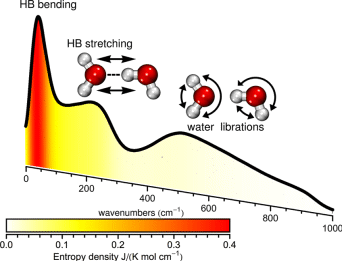
Far Infrared Light
One of the reasons FIR has beneficial results in a variety of illnesses is the ability of FIR waves to remove toxins,
which are often at the core of many health problems. Since humans are bio-accumulators, numerous toxins, that cannot be removed immediately after entry, are stored in our bodies. For example, when toxic gases such as sulfur dioxide, carbon dioxide or toxic substances such as lead, mercury or chlorine meet large water molecules, they are encapsulated by the clusters of water. Where these toxins are accumulated, blood circulation is blocked and cellular energy is impaired.
However, when a 10 micron FIR wave is applied to these large water molecules, the water begins to vibrate.
This vibration reduces the ion bonds of the atoms which are holding together the molecules of water. As the breakdown of the water molecules occurs, encapsulated gases and other toxic materials are released.
More about Infrared Light
Ultraviolet Light
Ultraviolet Light (UV Light) germicidal irradiation has been studied since the 1930’s and has been used to destroy the microbes that cause indoor air and water pollution. For many years, the medical industry has used UV light to sanitize rooms and equipment. The Centers for Disease Control recommend UV lamps for their germicidal effect.
How Does UV Disinfection Work?
UV-C light deactivates the DNA of bacteria, viruses and other pathogens, which destroys their ability to multiply and cause disease. As UV light penetrates through the cell wall and cytoplasmic membrane, it causes a molecular rearrangement of the microorganism's DNA, which prevents it from reproducing. Specifically, UV-C light causes damage to the nucleic acid of microorganisms by forming covalent bonds between certain adjacent bases in the DNA. The formation of such bonds prevent the DNA from being unzipped for replication, and the organism is unable to reproduce. In fact, when the organism tries to replicate, it dies.
UV light is MUST for any one with a well.
What is Ultraviolet (UV)?
Ultraviolet light is electromagnetic radiation with a wavelength shorter than that of visible light. The spectrum consists of electromagnetic waves with frequencies higher than those that humans identify as the color violet (purple).
UV light is typically found as part of the radiation received by the Earth from the Sun. Most humans are aware of the effects of UV through the painful condition of sunburn.
Ultraviolet germicidal irradiation has been studied since the 1930’s and has been used to destroy the microbes that cause indoor air and water pollution. For many years, the medical industry has used UV light to sanitize rooms and equipment. The Centers for Disease Control recommend UV lamps for their germicidal effect.
UV can be separated into various ranges, with short range UV (UV-C) considered "germicidal UV." At certain wavelengths UV is mutagenic to bacteria, viruses and other micro-organisms. Ultraviolet light is part of the light spectrum, with UV-C from 100 nanometers (nm) - 280 nm; UV-B from 280 nm - 315 nm; and UV-A from 315 nm - 400 nm. Optimum UV germicidal action occurs around 260 nm.

How Does UV Disinfection Work?
UV-C light deactivates the DNA of bacteria, viruses and other pathogens, which destroys their ability to multiply and cause disease. As UV light penetrates through the cell wall and cytoplasmic membrane, it causes a molecular rearrangement of the microorganism's DNA, which prevents it from reproducing. Specifically, UV-C light causes damage to the nucleic acid of microorganisms by forming covalent bonds between certain adjacent bases in the DNA. The formation of such bonds prevent the DNA from being unzipped for replication, and the organism is unable to reproduce. In fact, when the organism tries to replicate, it dies.
|
Common Microorganisms Destroyed by UV Light:
-
- Bacillus anthracis
-
- Corynebacterium diphtheriae
-
Dysentary
bacilli
(diarrhea)
-
- Escherichia coli
(diarrhea)
-
- Legionella pneumophilia
-
- Mycobacterium tuberculosis
-
- Pseudomonas aeruginosa
-
- Salmonella
(food poisoning)
-
- Salmonella paratyphi
(enteric fever)
-
- Salmonella typhosa (typhoid
fever)
-
- Shigella dysentariae
(dysentery)
-
- Shigella flexneri
(dysentery)
-
- Staphylococcus epidermidis
-
- Streptococcus faecaelis
-
- Vibro commo
(cholera)
-
- Bacteriophage
(E. Coli)
-
- Hepatitis
-
- Influenza
-
- Poliovirus
(poliomyelitis)
-
- Baker's Yeast
|
What are the Advantages of UV Disinfection?
Universally accepted disinfection system for potable and non-potable water systems.
Low initial capital cost as well as reduced operating expenses when compared with similar technologies such as ozone, chlorine, etc.
Immediate treatment process, no need for holding tanks, long retention times, etc.
Extremely economical, hundreds of gallons may be treated for each penny of operating cost.
Low power consumption.
No chemicals added to the water supply - no by-products (i.e. chlorine + organics = trihalomethanes).
Safe to use.
No removal of beneficial minerals.
No change in taste, odor, pH or conductivity nor the general chemistry of the water.
Automatic operation without special attention or measurement, operator friendly.
Simplicity and ease of maintenance, TWT Deposit Control System prevents scale formation of quartz sleeve, annual lamp replacement, no moving parts to wear out.
No handling of toxic chemicals, no need for specialized storage requirements, no OHSA requirements.
Easy installation, only two water connections and a power connection.
More effective against viruses than chlorine.
Compatible with all other water processes (i.e., RO, filtration, ion exchange, etc.).
|
Since natural germicidal UV from the sun is screened out by the earth's atmosphere, we must look to alternative means of producing UV light. This is accomplished through the conversion of electrical energy in a low pressure mercury vapor "hard glass" quartz lamp. Electrons flow through the ionized mercury vapor between the electrodes of the lamp, which then creates UV light.
Suspended solids or particulate matter can cause a shielding problem in which a microbe may pass through the UV filter without actually having any direct UV penetration. Iron/Manganese will cause staining on the quartz sleeve that houses the UV bulb, at levels as low as 0.3 PPM of iron and 0.05 PPM of manganese. UV filters are best used AFTER adequate sediment, turbidity, iron, and manganese filtration.
See our Whole House Water Filter here
Put Ultraviolet light to work for you with your own UV light water treatment system.

99.99% germicidal disinfection against bacteria and viruses!
-
Reduces: Lead, Chlorine, bad tastes, odors
-
NSF tested and certified to Standard 53 for the reduction of Lead and Cysts
-
California Prop 65 certified
-
Ideal for Homes, Office, RV's and boats
-
Includes dedicated faucet or can be connected to cold water line
304ss chamber, electronic ballast with audible and visual alarm, lamps rated for 30 mj/cm2 @ end of lamp life (9,000 hrs), single lamp per vessel, 3/4 in. MNPT, 110v or 220v.
NOTE: we no longer stock this item. Contact
www.watts.com for
info.
|
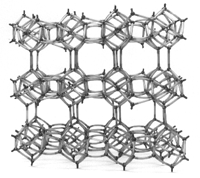 |
-
CLINOPTILOLITE FRAMEWORK MODEL
-
-
VIEW ALONG CLEAVAGE PLANE
-
-
OF CRYSTAL PLATES
|
| |
Zeolites - Exactly what are they?
Compositionally, zeolites are similar to clay minerals. More specifically, both are alumino-silicates. They differ, however, in their crystalline structure. Many clays have a layered crystalline structure (similar to a deck of cards) and are subject to shrinking and swelling as water is absorbed and removed between the layers. In contrast, zeolites have a rigid, 3-dimensional crystalline structure (similar to a honeycomb) consisting of a network of interconnected tunnels and cages. Water moves freely in and out of these pores but the zeolite framework remains rigid. Another special aspect of this structure is that the pore and channel sizes are nearly uniform, allowing the crystal to act as a molecular sieve. The porous zeolite is host to water molecules and ions of potassium and calcium, as well as a variety of other positively charged ions, but only those of appropriate molecular size to fit into the pores are admitted creating the "sieving" property.
Another important property of zeolite is the ability to exchange cations. This is the trading of one charged ion for another on the crystal. One measure of this property is the cation exchange capacity (CEC). Zeolites have high CEC's, arising during the formation of the zeolite from the substitution of an aluminum ion for a silicon ion in a portion of the silicate framework (tetrahedral units that make up the zeolite crystal).
more about zeolites
Ionic Purification
(Ion Exchange)
Ions and Water - Time for a little chemistry.
Water and the materials dissolved within it are made up of ions.
Ions are atoms that are electrically charged and are commonly the building blocks for other molecules. The charge may be positive or negative, depending on the type of ion, with every ion having a charge which cannot change. In electrolysis, which involves the use of two oppositely charged electrodes (negative and positive) to separate out ions in a solution, the positive electrode is called the anode and the negative electrode is called the cathode. Consequently, negatively charged ions are attracted to the positively charged anode (and are therefore called anions), where as the positively charged
cations are attracted to the negative cathode.
Anions are negatively charged ions, formed when an atom gains electrons in a reaction. Anions are negatively charged because there are more electrons associated with them than there are protons in their nuclei.
Cations are positively charged ions, formed when an atom loses electrons in a reaction. Cations are the opposite of anions, since cations have fewer electrons than protons.
|
For example, if salt (sodium chloride) is put into water, it dissolves and then dissociates into two separate ions - a positive sodium ion (or cation, Na+), and a negatively charged chloride ion (or anion, Cl-). So in solution, sodium chloride no longer exists and it's ions are free to move and combine with other ions of an equal and opposite charge.
Consequently, all ions can be split into two groups; the positively charged cations such as calcium, magnesium, sodium, iron (all metals) and the negatively charged anions such as bicarbonate, carbonate, chloride, sulphate, nitrate etc.
Fortunately, the vast majority of impurities and inconsistencies between our tap water and that of pure water
are due to an excess of specific ions. And as these ions will either have a negative or positive charge, with a little applied chemistry, we can target and remove these offending ions using water purifiers.
Next: Dealing with the dissolved ions.
After the initial filter media have worked on the raw tap water, there should only be a significant quantity of inorganic compounds remaining as ions which can then be removed using ion exchange technology.
What is ion exchange?
Ion exchange is a reversible chemical process in which the specific ion (such as sodium, Na+) are released from the insoluble solid medium (which is the ion exchange resin) and exchanged for non-desirable, or target cations, such as heavy metals. There are two types of ion exchange that can be caused to occur within a water purifier; that which removes target cations and that which removes target anions.
Ion exchange was first discovered in 1845 by an Englishman called Thompson who passed an ammonia-rich solution of manure through some ordinary garden soil, only to discover that the ammonia content of the liquid manure was greatly reduced. It was later shown that the soil contained fine particles of a natural material called zeolite which would even later be shown to have ion exchange properties. The water industry has not looked back since, but developed better and more efficient media to do the job of water purification.
How cation exchange works.
Cation exchange resins are usually made from an inert compound called polystyrene-divinylbenzene which is heated in its manufacturing process with concentrated sulphuric acid, causing a sulphonic group (SO3-) to be permanently fixed on to the structural chemistry of the resin beads. Because these sulphonic groups have a negative charge, they can be charged with positively charged ions (cations) typically sodium (Na+), potassium (K+) or even hydrogen (H+).
When tap water containing dissolved cations (such as heavy metals) pass by the resin, then these are exchanged for, and trade places with, the loosely held sodium ions on the resin. There will come a time when no more cations can be removed by a fully reacted resin which is then described as being 'exhausted', and which must then be replaced.
The better a resin is protected by pre-filtration from fouling contaminants such as iron and chlorine (which can actually cause the resin polymer beads to disintegrate), the longer it's active life will be. Cation exchange resins will remove most metallic, positively charged ions such as barium, cadmium, copper, iron, manganese, zinc, calcium and magnesium.
Consequently, if the flow rate has been sufficiently slow and there has been sufficient active areas for cation exchange on the resin, then the levels of contaminant cations are reduced, and retained within the resin. All this leaves is the negatively charged contaminants or anions which must then be removed.
How anion exchange works.
Anion exchange units use a different resin that works in the opposite way to a cation exchange resin. It is charged with either chloride (Cl-) or hydroxyl (OH-) ions, are then released into the water in exchange for the less desirable contaminant anions. Anion exchange removes nitrates, sulphates and other negatively charged ions.
What is the difference between absorption and adsorption?
A sponge absorbs water into the inside of it's porous structure. Ion exchange resins are not porous and so we describe the action by which they attract and retain ions on to their surface as adsorption.
There are several new generation adsorptive media that seek to replace or improve upon the purifying performance of activated carbon. Some are natural media, while others boast patented technology that enables them to adsorb most heavy metals and dissolved gases.
Mixed bed ion exchange.
As the term suggests, these ion exchange media contain both anionic and cationic exchange media, combined in one cartridge. To ensure that there is efficient purification, mixed bed ion exchange resins are usually used in a series of multiple cartridges, preceded as ever, by at least a carbon filter and at best an additional fine micron mechanical pre-filter.
In summary, water purification uses a series of complementary filtration processes that involve both mechanical and chemical means to produce 'purified' water. Our tap water can deliver quite unpredictable levels of ions and other 'contaminants' such as herbicides and pesticides, as well as chlorine and chloramine. Different purifiers boast different qualitative and quantitative performance figures; a function of the different types and configurations of media used in these purifiers. The team of different media work to target and remove these contaminants, whether they are present in our tap water or not. It never ceases to amaze me that by using the innate 'electrical' features of the dissolved contaminants themselves, the manufactured media or resins can effectively remove them from tap water, with no power or electricity required to power them.
- Portion of the above excerpt provided by "The Pond Doctor"
see our water ionizers here
KDF
( Kinetic Degradation Fluxion) -
Redox
(more ion exchange)
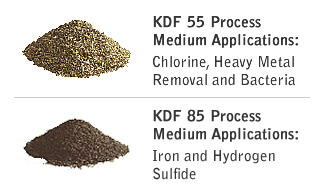
KDF is a
patented media that is a giant step forward in water purification.
KDF media utilizes an old process in a new way - the oxidation and reduction of ions, known as redox... the principle of
Oxidation-Reduction or Redox potential. Redox media remove virtually any soluble heavy metal, help prevent mineral hardness scale accumulation, and reduce levels of microorganisms.
Redox reactions,
or oxidation-reduction reactions, primarily involve the transfer of electrons between two chemical species. The compound that loses an electron is said to be oxidized, the one that gains an electron is said to be reduced.
KDF process media are high-purity copper-zinc granules used in a number of pretreatment, primary treatment and wastewater treatment applications. KDF media supplement or replace existing technologies to dramatically extend life of the system, control heavy metals, toxic gases and microorganisms, lower total cost, and decrease maintenance. KDF process media work to reduce or remove chlorine, iron, hydrogen sulfide, lead, mercury, calcium carbonate, magnesium, chromium, bacteria, algae, fungi, and much more!
Iron and hydrogen sulfide are oxidized into insoluable matter and attach to the surface of the media. Heavy metals
such as lead, mercury, iron, cadmium and aluminum are removed from the water by the electrochemical process. They are attracted to the surface of the media, much like a magnet.
In short, the redox process works by exchanging electrons with contaminants. This give and take of electrons converts many harmful contaminants into harmless components, such as chlorine to chloride. Other contaminants, including heavy metals, bond to the KDF media, which greatly reduces or virtually eliminates these substances.
The media also inhibits bacteria, algae, and fungi growth.
KDF process media control microorganisms in two ways. The first is a by-product of redox; the exchange of electrons sets up an electrolytic field in which most microorganisms cannot survive. Secondly, the process of forming hydroxyl radicals and peroxides from some of the water molecules interferes with the microorganisms' ability to function.
Electrolysis
Electrolysis of water is the decomposition of water (H2O) into oxygen (O) and hydrogen gas (H2) due to an electric current being passed through the water. This electrolytic process is used in some industrial applications when hydrogen is needed.
An electrical power source is connected to two electrodes, or two plates, (typically made from some inert metal such as platinum or stainless steel) which are placed in the water. Hydrogen will appear at the cathode (the negatively charged electrode, where electrons are pumped into the water), and oxygen will appear at the anode (the positively charged electrode). The generated amount of hydrogen is twice the amount of oxygen, and both are proportional to the total electrical charge that was sent through the water.
During this process, H+
cations will accumulate at the anode and OH−
anions will accumulate at the cathode. This can be verified by adding a pH indicator to the water: the water near the anode is acidic while the water near the cathode is basic.
see our electrolyses machines here
Activated Alumina
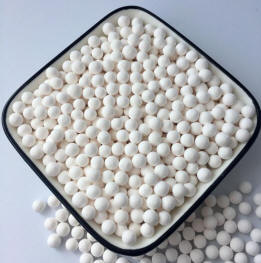
A major breakthrough in Fluoride and Arsenic removal.
(Also removes fluorine, selenium and sulfur.) Most of us know Arsenic is a poison. How many of you know Fluoride is too?!!!
It is made of aluminium oxide (alumina; Al2O3), the same chemical substance as sapphire and rubies (but without the impurities that give those gems their color). It has a very high surface-area-to-weight ratio. That means it has a lot of very small pores, like tunnels, that run throughout it. This material can have a surface area significantly over 200 square meters per gram.
As water is passes through this highly porous material, it adsorbs and traps the poisons mentioned. Lower temperature water, and lower pH water (acidic water) are filtered more effectively too.
Read More.
Magnetic Fields and Water
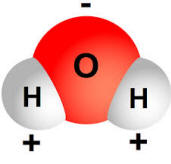
At first site, water seems to be a very simple molecule, consisting of just two hydrogen atoms attached to an oxygen atom. Indeed, there are very few molecules that are smaller or lighter.
However, untreated water molecules tend to
cluster in large unorganized globs of water
molecules. This messy cluster tends to
'hold' many contaminants such as
calcium carbonate
and magnesium carbonate (scale), and
doesn't penetrate cell walls very efficiently.
Once a water molecule has been exposed to a magnetic field the molecule changes in several ways:
1. The molecule
cluster is broken apart and reduced in size to
mother nature's most efficient form... small
clusters, usually of 6 water molecules. This increases the water solubility and permeability (the ability to disperse and penetrate other substances). The increase in permeability assists in the dissolution of
nutritional substances, and improves the body's absorption of water as well as the nutritional substances.
This also makes is easier for toxins and cellular
waste to be flushed from cells much easier.
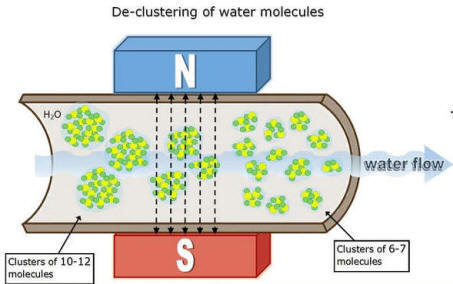
2. The surface tension and density of the water is increased. The increased surface tension, permeability, and density all combine to improve the intake of
nutrition in the body's cell structure. Increased surface tension allows the cell membrane of the food to expand rapidly. This is beneficial to digestion. The increase in density also aids in the absorption of nutrition.
3. The ions in the water are affected.
This has the effect of reducing free radicals
contained within the water (free radicals are harmful substances found in the body). A further benefit of the alteration to the ion states of both calcium carbonate and magnesium carbonate is this: the structure of these compounds (which are the cause of the scale build up in water pipes, kettles, taps, etc) changes, resulting in a much decreased build up of scale due to the looser nature of the ions. (SOFT WATER) This decrease in scale build up has resulted in extensive use of magnetized water in central heating systems, water cooling systems in engines,
recycling water systems, and house water systems.
Yes, magnetized water will DE-SCALE your
current plumbing lines, water heater, etc...
Read more about magnets and water here
Reverse Osmosis
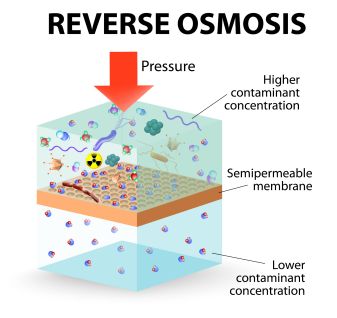
Reverse osmosis does
remove toxins from water when pressure forces it through a semi-permeable membrane. Water flows from the
more concentrated side (more contaminants) of the membrane to the less concentrated side (fewer
contaminants) to provide clean drinking water. The
fresh water produced is called the permeate,
and the waste water left over is called
brine. A semi-permeable membrane has
small pores that block contaminants, but allow water
molecules to flow through. In osmosis,
water becomes more concentrated as it passes through
the membrane to obtain equilibrium on both
sides. Reverse osmosis, however, blocks contaminants
from entering the less concentrated side of the
membrane. For example, when pressure is applied to a
volume of saltwater during reverse osmosis, the salt
is left behind and only clean water flows through.
The RO
membrane is the focal point of a reverse osmosis
system, but an RO system also includes other types
of filtration. RO systems are made up of 3, 4, or 5
stages of filtration. Every reverse osmosis water system
contains a sediment filter and a carbon filter in
addition to the RO membrane. The filters are called
either pre-filters
or post-filters depending on whether water passes
through them before or after it passes through the
membrane.
Each type of system contains one or
more of the following filters: 1) sediment filter: Reduces
particles like dirt, dust, and rust/ 2)Carbon filter: Reduces
volatile organic compounds (VOCs), chlorine, and
other contaminants that give water a bad taste
or odor. 3) Semi-permeable membrane: Removes
up to 98% of total dissolved solids (TDS)
A NOTE about Reverse Osmosis
filtration systems:
RO systems do NOT remove
microbiological contaminants. In fact, they are
known to act as breeding grounds for
bacteria. (Especially when the filters are not
changed regularly!) One of the pivotal studies which
conclusively proved that reverse osmosis systems
acted as intensive breeding grounds for bacteria
appeared in Applied and Environmental
Microbiology, April 1991. p945-948.
In this milestone study, entitled
"Gastrointestinal Health
Effects Associated with the Consumption of Drinking
Water Produced by Point-of-Use Domestic
Reverse-Osmosis Filtration Units",
individuals who drank water treated with reverse
osmosis systems were experiencing gastrointestinal
problems equivalent to those experienced in the
Third World.
In addition to the bacterial
problem, reverse osmosis is also known to form pentagon shaped
water molecules. This is an un-natural
type of water. Cellular physicist,
Dr. Hulda Clark,
speaks to this in her book, "The Cure and Prevention
of All Cancer", which is largely an expose on our
water supplies in the USA. What she tells is
that healthy tissue in our bodies is organized into
clusters of SIX molecules, while unhealthy tissue
such as tumors or diseased organs lose a bond and
form FIVE sided molecules like RO water. She
called it "disease water". She also mentions
that some RO systems create potassium nitrite as an
ingredient in the finished water, which can be
toxic, especially to the nervous system.
We do NOT recommend RO water.
see more about
hexagonal water here
-
-
Some of our favorite water
products.. .
-
The "Ultimate" Drinking
Water Filter
-
This ONE Water Filter Removes More Contaminants Than ANY Other!
Water filters are no longer a
luxury, they are a necessity! After 17years of
researching water filter technology, we still say we have the
best water filter in the world! Period.
- Just look at all these
Features!
|

|
Removes
BROADEST RANGE of CONTAMINANTS!
|
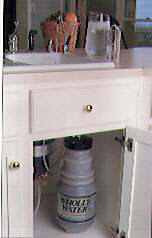
|
|

|
No
replacement cartridges or membranes to change!
SAVES $1000's vs. other water filters!
|
|

|
Estimated life of filter is 10-12 years! (40,000 Gallons!)
|
|

|
Pristine
water for less than 1¢ per gallon!
|
|

|
Patented
5 filter bed, multi-filter layered system
|
|

|
17 lbs. of filter media; a WHOPPING 440 cubic inches!
|
|

|
2 Year Warranty
|
|

|
Flow Rate of 1 gallon per
minute
|
|

|
Easy
do-it-yourself installation
|
|

|
Easy back wash eliminates
need for replacement rartridges (approx. every 3-4 months)
|
|

|
Push-button,
leak-free quick disconnects reverse the water flow.
|
|

|
Better than
bottled water, Better than R/O.
|
|

|
Fits under almost any sink.
19" height,
8" diameter, approx. 23 lb.
|

|
-
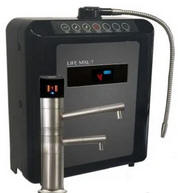 Alkaline Water
Ionizers Alkaline Water
Ionizers
-
The Most
Powerful Water in Existence!
-
Filtered and ionized for purity, high alkaline (pH), anti-oxidant
electron-rich, micro-clustered,
hydrogen-saturated,
oxidation-reduced,
powerful living water!
This amazing
water Flushes
Toxins and Neutralizes Acid throughout your
ENTIRE body.

|
 Prozone
5000 Ozone Generator Prozone
5000 Ozone Generator
Ozone Therapy Water for Home Use!
-
Ozone is a TRUE sterilant.
Ozone is not just another disinfectant...
it has the ability to completely destroy bacteria, viruses, spores,
fungus, mold, mildew, cysts, and nearly ALL
contaminants like chemicals, metals, VOC's,
and much more! Ozonate
your drinking water and
olive oil to aggressively detoxify your body!
Both the FDA and EPA certify that ozone
destroys 99.9992% of all pathogenic germs, while
oxidizing (destroying) 99.9992% of all
pollutants in the water at the same time.
|
-
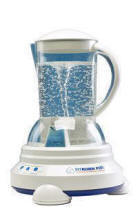 The Vitalizer Plus The Vitalizer Plus
-
Make Your Own Structured Hexagonal Water
The
Vitalizer Plus
will rejuvenate you! The health
benefits of structured “hexagonal” water are well
documented: Super cellular hydration… Increased cellular
nutritional delivery and Waste removal...
Increased
Oxygenation at the cellular level.
Electron-rich, free-radical neutralizaton, and
cleansing. High Alkaline pH.
Enhance
endurance and reduce recovery time from strenuous
exercise.
Activate enzymes, immune system
support and greater metabolic balance!

|
|

Whole
House Water Filter
Filters every drop of water entering the house
P rovides clean,
soft water to all sinks,
refrigerator, showers, tubs,
dishwasher, and washing machine. Natural
water softener leaves healthy minerals in!
The patented multi-field water conditioning unit is
a critical component in every Water Boy system. The
multi-field module conditions the water
non-chemically by restructuring and realigning the
polarity of the mineral molecules, without removing
the minerals from the water.
 |
.png)


These statements about water, water filtration, water filters,
water filtration techniques, etc... have not been evaluated by
the Food and Drug Administration. The information contained here
about water filters is not intended to diagnose, treat, cure, or
prevent any disease. Readers are encouraged to consult
their health care provider before beginning any "alternative"
protocol. Water filter page.
|
 Prozone
5000 Ozone Generator
Prozone
5000 Ozone Generator